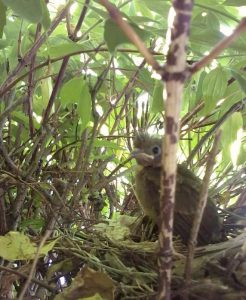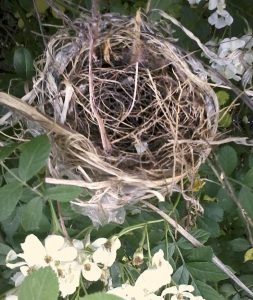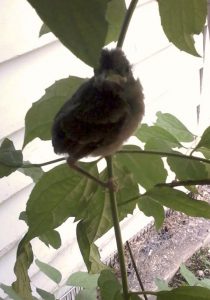Theatre fans might remember Porgy and Bess. “Summertime and the livin’ is easy…”
As the days lengthen and the trees put on their verdant foliage, birds begin to nest and brood. This is a strenuous time for our feathered neighbors and our yards serve as their native habitat. A little extra food from a bird feeder is much appreciated.
We often think of ecology and sustainable wildlife interactions as things that happen in a tropical rainforest or out in the great park systems – but environmental stewardship happens in our backyards. In fact, backyard is a relative term; as yours may be bordering the Sundarbans, the Amazon or the Chevy blue American “crick”. Our local birds need just a few things to stay focused and unencumbered as they rear their fledglings for another summer season.
Building the Bird-Friendly Backyard
A few important points:
- Do not impede or remove all natural “cover”.
- Provide fresh water sources if no natural ones are available.
- Keep pets and children away from nesting sites.
- Avoid dangerous chemicals and rodenticides.
 Natural “cover” refers to the brush, edges where grass meets trees or shrubs, and areas that are left un-mowed. Golf course lawns are great on golf courses, but they offer very little in terms of songbird habitat. Unless you are raising geese, erasing all greenery that grows more than 3 inches tall and cutting down all shrubs and trees will ensure you will be offering insignificant habitat for songbirds. And we all know how bad loss of songbird habitat can be for our ecosystems.
Natural “cover” refers to the brush, edges where grass meets trees or shrubs, and areas that are left un-mowed. Golf course lawns are great on golf courses, but they offer very little in terms of songbird habitat. Unless you are raising geese, erasing all greenery that grows more than 3 inches tall and cutting down all shrubs and trees will ensure you will be offering insignificant habitat for songbirds. And we all know how bad loss of songbird habitat can be for our ecosystems.
Cornell University Ornithology department recommends limiting lawn space as monoculture has known drawbacks.
If you have an expanse of grass, try to break it up by planting islands of perennials, trees and shrubbery – not only is this far more visibly appealing, but biodiversity is beneficial to the lawn as well. Consider adding a pond into the landscape. The wildlife will send you thank you notes!
What to plant to attract birds
Plant shrubs and trees that attract and foster songbirds and other bird species (insect eaters such as swallows and phoebes, wetland fowl and osprey, whip-poor-will and bobwhites, owls and raptors). Read the labels on these bushes when you visit the nursery. Often you will notice the description stating that birds will eat the fruit or use the body of the shrub. Some great choices are holly, mock orange, boxwood and viburnum.
Choose vines that help out the bees and the hummingbirds – trumpet vines, honeysuckle, bougainvillea and jasmine. Keep track of where you find bird nests, even the old ones. The birds will often choose to nest again in these areas and you can get ideas about what nesting sites they like the best. Always check tree limbs and brush for fledglings and nests before trimming or pruning.
Plant trees of all kinds!
 Nut trees, including small growing types such hazelnut are great sources of food for jays, and the insects that visit these nut producers attract other birds including the bluebird. Apples feed everyone! The spring buds and flowers bring in the orioles and the sparrows. The fruits provide snacks for robins and catbirds. “Berry” trees like dogwood, cherry and elderberry call in the mockingbirds, catbirds and waxwings. Cornell University stresses the importance of choosing local varieties of trees and shrubs to meet the birds’ needs. Evergreens and other dense growing trees are perfect as weather canopies and windbreaks.
Nut trees, including small growing types such hazelnut are great sources of food for jays, and the insects that visit these nut producers attract other birds including the bluebird. Apples feed everyone! The spring buds and flowers bring in the orioles and the sparrows. The fruits provide snacks for robins and catbirds. “Berry” trees like dogwood, cherry and elderberry call in the mockingbirds, catbirds and waxwings. Cornell University stresses the importance of choosing local varieties of trees and shrubs to meet the birds’ needs. Evergreens and other dense growing trees are perfect as weather canopies and windbreaks.
Don’t forget to leave piles of logs and brush, including bramble, in discreet areas of the property as these serve important habitats for birds – especially for tiny wrens, kinglets and native sparrows.
Gardeners can plant sunflowers, sorghum, thistle and millets, strawberries, blueberries, raspberries and other treats. And don’t forget, adding stands of phlox and monarda. Beautyberry and butterfly bushes help round things out.
It is important to leave shrubs dense and trees lightly pruned. Birds will use these areas for cover when roosting and nesting.
Simply think of your yard as an ecosystem.
Once you do that – everything else falls into place. Deciding to plant a few Alberta spruce and arborvitae (or yew, blue spruce, balsam…) instead of a few deciduous straggling ornamentals makes a world of difference for your small beaky buddies. It is actually a snap to cultivate a stunning landscaped yard that is really for the birds!
Read on for a few in-depth ways to meet the top four needs for birds during the warm summer months.
Prevent Pets From Stressing Birds
 We love our furry family members and our two-legged kids. While we may have to curtail Bootsies’ feline meanderings during the nesting season (bells on collars can help – but not all birds will associate the ring sound with a predator), we may need to think about “Old Rufus” as well, since dogs are also predators.
We love our furry family members and our two-legged kids. While we may have to curtail Bootsies’ feline meanderings during the nesting season (bells on collars can help – but not all birds will associate the ring sound with a predator), we may need to think about “Old Rufus” as well, since dogs are also predators.
One environmental side effect of keeping dogs and cats as pets is that they are predators and birds – especially fledglings – are very vulnerable. Recent studies, including one from 2013 in the peer-reviewed journal, Nature Communications, collected evidence that as many as 1-3 million birds are killed by pet cats every year. The study concluded that domestic cats were a very significant threat to wildlife – especially to birds. The family dog may just be “playing,” but it is a life and death game for the birds. Just the continued presence of these pets can create stress that may result in illness and unsuccessful hatches in the songbirds. Well-trained and animals with low prey instincts work well. Not all cats or dogs are natural killers – know your pet and watch how the local wildlife reacts.
Those of us lucky enough to have livestock around will enjoy many feathered visitors! Since livestock species are usually herbivores they are well received by wild birds. Fellow avian friends we have in our homes are great for attracting wild birds. Birds love to see other birds and this is yet another perfect recent to join the ranks and become part of the recent surge in chicken –keeping! Farms are no stranger to barn swallows and owls. Think about adding bat and birdhouses to your acreage and barns. Check out the many bat and birdhouses available. These are designed to assist brooding avians and many add whimsy as well.
Water… water…. water!
Birds need a water source and once you supply one – they will come.
Provide clean and fresh water in birdbaths. You can even buy birdbaths that keep the water moving. A step up from this is to provide a fountain. The water is oxygenated and the mosquitoes will not be able to breed in moving water.
Sprinklers are another fun source for getting the birdies hydrated while they get a shower. Soft spraying sprinklers are fun for the kids and the doggies – bring everyone out of the way once they are done playing and watch the birds fly in for a shower. Hummingbirds love sprinklers.
If you can add a pond to your yard – do so. Ponds, with fish to keep the bugs down and the necessary fountain system, are bird magnets (be sure the pond is at least 3 feet deep in the center to prevent freezing and to give fish and amphibians a place to avoid the herons that fly in!) In cold climates a pond heater keeps water areas open for gas exchange as well as providing a drinking area for birds and other wildlife.
Teaching Kids About Bird Watching
Bird watching is a phenomenal way to teach kids the value of empathy and that others have importance and feelings. Summer is high time to get bird watching. Use your wild bird feeders, water areas and landscaping features to get the kids into wildlife. Children are natural ecologists and it doesn’t take much to steer that passion.
Set out bird feeders and have the kids write down when the birds are feeding and what species are coming by. Hummingbirds are a real treat to watch and finding their nests is a mystical experience. Hang hummer feeders and fill with the special nectar mixes.
Get children involved in setting up ecosystems to attract different species – a wild cherry tree for waxwings; mealworm bowls for bluebirds and a special brush pile for wrens. Point out nesting sites and watch the eggs hatch and the nestlings fledge! Showing children that they can be actively involved in bonding and being with other animals is a lifelong gift that keeps on giving. Read more about teaching kids to be avian savvy at All About Birds.
Protecting Birds from Chemicals
Chemicals and poisons have no place in an ecologically minded landscape. The impact that these toxins have on our animal neighbors is significant. There is no safe rodent poison. Recent studies and workshops from Tufts University Wildlife Clinic have proven that many a raptor has succumbed to these poisons through secondary toxicity. Animals and birds ingest the poisoned rodents — often many at a time – leading to deadly consequences. Studies have shown that raptors (owls and hawks) are especially drawn to the weak and dying rodents – easy meals, and often their last ones.
Being a birder and a summer fun lover is easy – they go hand in hand… or hand in wing!
- Footnote: Poultry keepers need to be vigilant and monitor state agricultural reports. Wild birds can and do transmit diseases to poultry – limit contact with sparrows and wild waterfowl. While much of the reports are overblown – take sensible biosecurity precautions.


